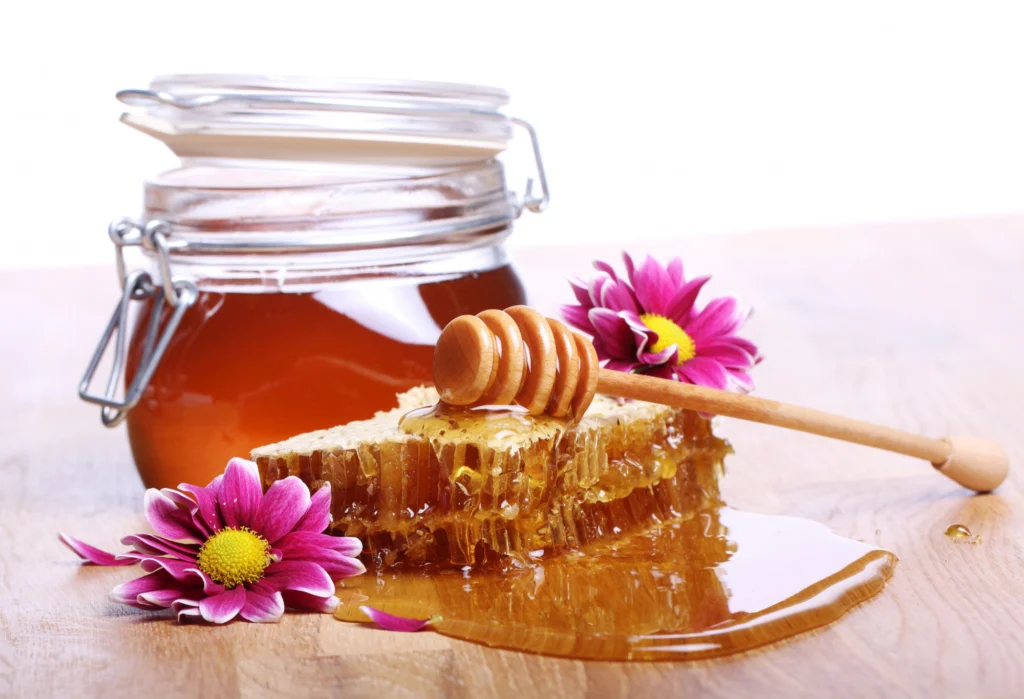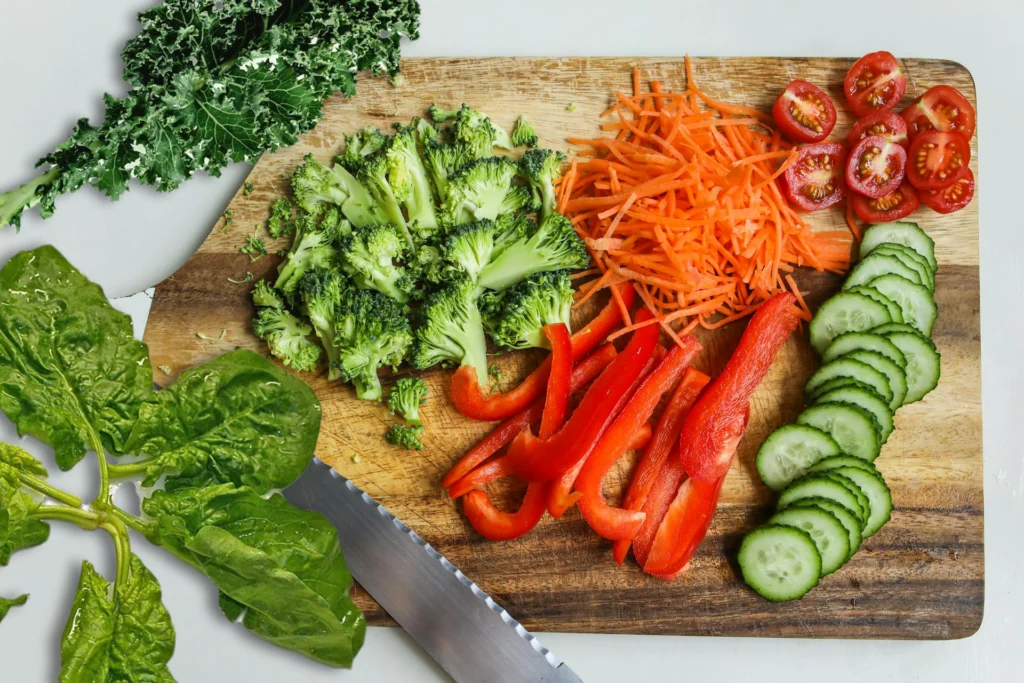Eating more fruits and vegetables is one of the best things you can do for your health. But not all produce is equally clean. That’s why understanding the Dirty Dozen vs Clean 15 — two produce safety lists shared by the EWG each year — helps you shop smarter without going fully organic.
Released annually by the Environmental Working Group (EWG), the Dirty Dozen vs Clean 15 rankings are designed to help you decide where going organic matters most — and where you can confidently save.
Let’s break down what these lists really mean — and how you can use them smartly in your everyday life.
What Are the Dirty Dozen and Clean 15 Lists?
Every year, the Environmental Working Group (EWG) analyzes testing data from the USDA and FDA. Based on these tests, they publish the Dirty Dozen and Clean 15 — two separate lists ranking fruits and vegetables by the amount of pesticide residues found after washing and peeling.
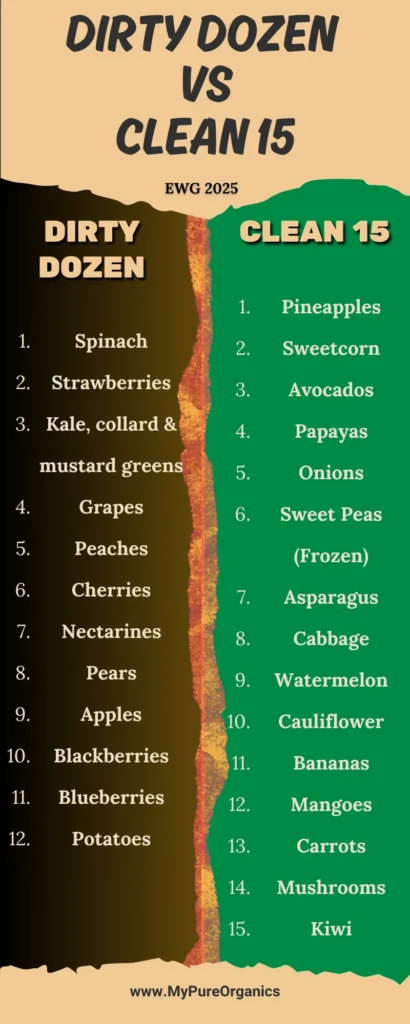
Published by the Environmental Working Group (EWG)
The EWG is a nonprofit organization focused on public health and environmental research. Their annual Shopper’s Guide is one of the most downloaded food safety resources in the U.S.
Purpose of These Lists for Everyday Consumers
The goal isn’t to scare you away from fruits and vegetables. It’s to help you make smarter choices, especially when your grocery budget can’t stretch for organic everything.
Where the Data Comes From
The lists are based on over 45,000 produce samples tested by the USDA Pesticide Data Program and FDA surveillance data. Each item is measured for both the presence and concentration of multiple pesticide residues — even after standard washing or peeling.
To keep it transparent, the Environmental Working Group (EWG) provides a yearly breakdown of this data, including how each fruit or vegetable performed across dozens of chemical tests. You can explore the full methodology, testing details, and how they score each crop in their official summary here.
It’s a useful behind-the-scenes look at how the Dirty Dozen and Clean 15 rankings are built — not just opinion, but actual residue data collected from real grocery stores across the U.S.
Dirty Dozen vs Clean 15: What’s the Real Difference?
The Dirty Dozen contains fruits and veggies with the highest levels of pesticide residues, even after washing and peeling.
The Clean 15, on the other hand, are produce items with little to no detectable pesticides, even when conventionally grown.
Dirty Dozen = Most Pesticide Residues
These are produce items where choosing organic really matters. Many of these have thin or edible skins that can absorb chemicals.
Clean 15 = Least Pesticide Residues
Thicker skins help certain fruits and vegetables stay naturally protected from pesticides. That’s why many items on the Clean 15 list, like avocados or onions, show little to no chemical residue — even when conventionally grown.
This matters even more when preparing food for babies. Parents often wonder if every ingredient must be organic. The truth? Some produce is already low-risk, and smart choices can go a long way.
If you’re just starting solids and want to understand which foods are safer and how to use them, check out this in-depth guide on Organic Baby Food 101. It breaks down what to prioritize and how to build confidence around early nutrition — even on a tight budget.
2025 Dirty Dozen List (With Quick Insights)
Here’s the Dirty Dozen 2025, based on recent testing:
- Spinach
- Strawberries
- Kale, collard, and mustard greens
- Grapes
- Peaches
- Cherries
- Nectarines
- Pears
- Apples
- Blackberries
- Blueberries
- Potatoes
Many of these tested positive for not just one — but several different types of pesticide residues. Some samples even revealed traces of a dozen or more chemicals, raising real concerns about long-term exposure.
If you want a deeper look at how each fruit or vegetable was scored, the Environmental Working Group shares a transparent summary each year. Their latest guide walks through the full test results, what they found in grocery store samples, and how rankings are determined.
Explore the full list and methodology in the 2025 Dirty Dozen list.
2024 Clean 15 List (What Makes Them Safer)
Here’s what’s on the Clean 15 2025 list:
- Pineapples
- Sweet corn
- Avocados
- Papayas
- Onions
- Sweet peas (frozen)
- Asparagus
- Cabbage
- Watermelon
- Cauliflower
- Bananas
- Mangoes
- Carrots
- Mushrooms
- Kiwi
Most of these tested clean in the majority of samples — a helpful fact if you’re weighing what to buy organic and what not to stress over.
For full transparency, you can view the official Clean 15 list as released by the Environmental Working Group here. The list and reflects the most current produce rankings for minimal pesticide exposure.
Why Pesticide Exposure Matters (Especially for Children)
Children’s bodies aren’t just smaller — they’re still developing. That makes them more vulnerable to chemical exposure, especially from everyday foods.
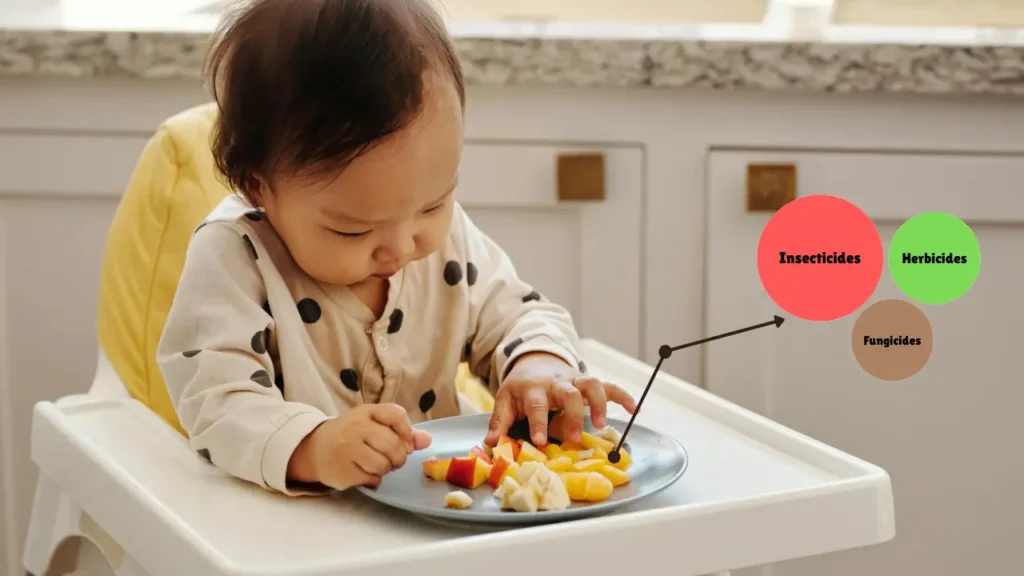
Impact on Developing Organs and Hormones
Children’s bodies process chemicals differently. Their brains, immune systems, and hormonal systems are still developing — which means even low-level pesticide exposure can have lasting effects.
Studies have linked certain pesticides to neurodevelopmental delays, hormone disruption, and behavioral issues in children.
What’s even more concerning is that many of the chemicals found on conventional produce—like chlorpyrifos and neonicotinoids—have been flagged for developmental concerns in children by both the EPA and peer-reviewed studies. These aren’t just theoretical risks. A large birth cohort study in New York found that higher prenatal exposure to pesticides was linked with lower birth weights and reduced IQ scores in early childhood. Small bodies process chemicals differently. That’s why something harmless for an adult might create real disruption in a toddler whose systems are still forming.
Should You Always Buy Organic?
The Dirty Dozen vs Clean 15 lists can serve as a realistic guide for deciding when to spend on organic and when conventional produce is perfectly fine.
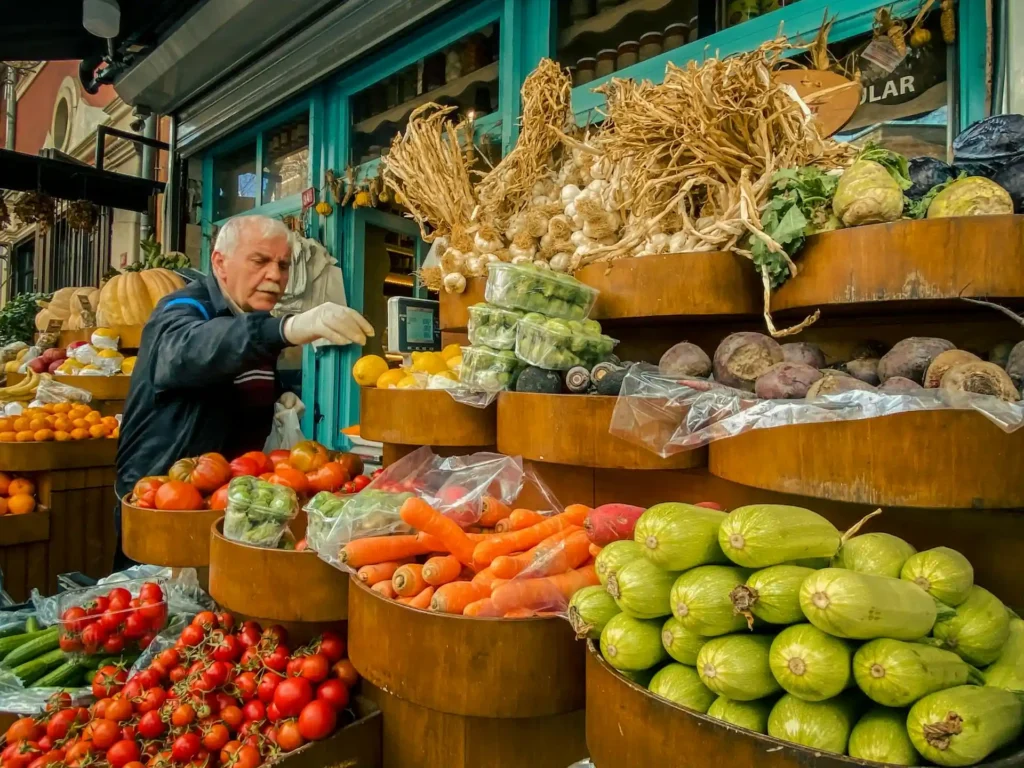
When It’s Worth It
If your budget is tight, prioritize going organic for the Dirty Dozen. These are the items with the most potential residue risk.
Frozen organic fruits and veggies are often more affordable and still nutrient-rich.
Some crops, like spinach or strawberries, tend to absorb more pesticides deep into the plant. In those cases, organic gives you a bit more peace of mind — especially for kids still growing and developing.
If you’re making baby meals and unsure where to start, these organic baby food recipes for 6–9 months can help you choose ingredients that align with both health and budget.
When It’s Okay to Skip
For Clean 15 foods, conventional versions are fine for most people. You still get the fiber, vitamins, and antioxidants — without worrying as much about residue.
Sometimes choosing conventional produce is simply what’s available — or what’s affordable that week. And that’s okay. According to USDA reports, many Clean 15 items like avocados, onions, and pineapples had zero detectable pesticide residues in more than 90% of samples. Their thick skins and low-residue profiles make them safer options when organic isn’t realistic.
Even frozen conventional options for these foods are still nutrient-dense. I always say: don’t let the perfect get in the way of the good. Clean eating includes flexibility — and the Clean 15 helps make that possible.
How the Lists Are Updated (And Why It Changes Each Year)
Every year, the USDA tests a different mix of fruits and vegetables, often rotating crops from various regions. So if a certain food drops or climbs in ranking, that’s often due to:
- New farming methods
- Import changes
- Weather conditions during harvest
These factors affect how produce ranks on the Dirty Dozen vs Clean 15 each year. One year I saw kale on the Dirty Dozen list and was honestly shocked. The year before, it wasn’t even mentioned.
That’s when I realized — these lists change because farming practices change. Pesticides used one season might not be used the next. Weather affects what pests show up. And when more residue gets found in routine tests, that item gets bumped up the list.
It’s not random — but it’s not set in stone either.
The USDA tests thousands of samples from grocery stores each year. EWG takes that data, analyzes how often pesticides are found, and how many are stacked on top of each other in a single item.
So yeah, the list shifts. And it should. Because food systems are always shifting too.
Debunking the Myths Around EWG Lists
Understanding the science behind pesticide testing is one thing — but there’s also a fair share of confusion, skepticism, and even controversy around the EWG’s annual produce rankings. Let’s clear up some of the biggest misconceptions.
“Is the Dirty Dozen List Anti-Farmer?”
Not at all. Many farmers use Integrated Pest Management (IPM) to reduce the need for harsh chemicals. The list simply reflects residue levels — not bad farming.
Some folks assume the lists paint farmers in a bad light. But really, they highlight how complicated food production is. In fact, many smaller farms use the attention to showcase their cleaner growing methods. It’s not a blame game. It’s a tool that helps conscious shoppers ask better questions—and rewards farmers who go the extra mile.
What Scientists Say About Real Risk
Some experts argue that the actual residue amounts are within “safe limits” set by government agencies. But critics point out that “safe” doesn’t always mean risk-free — especially with long-term, low-dose exposure.
The USDA Pesticide Data Program summary offers insight into how these limits are defined and monitored — providing the raw data behind both praise and criticism of EWG’s lists.
Organic Is Always Clean
Even organic produce can sometimes carry trace residues—not because it’s sprayed, but due to things like wind drift or cross-contamination during storage. It doesn’t happen often, but it’s a reminder: a rinse goes a long way. Whether it’s organic or not, washing your fruits and veggies is still a smart move.
Clean Eating Tips If You Can’t Always Buy Organic
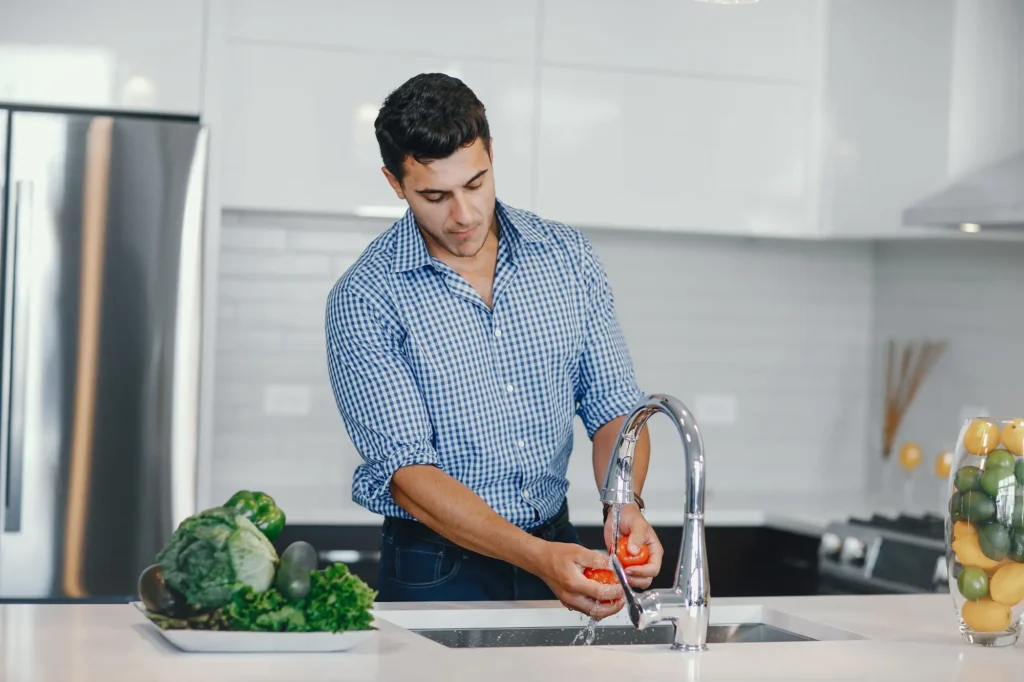
Wash and Peel
Rinse under cold water for 30+ seconds. Use a baking soda rinse for apples or firm produce. Peel fruits like apples or cucumbers when possible.
Let’s be real — most of us aren’t doing elaborate vinegar soaks on a Tuesday night.
But giving produce a good rinse still helps. I keep a bowl near the sink, fill it with cold water, and toss in whatever I’m prepping — apples, grapes, spinach. A quick soak and a scrub with my hands gets rid of dirt, dust, and some surface pesticides.
It’s not perfect. But it’s something. And when I don’t have time for that? I peel what I can. Even peeling a non-organic apple helps lower what ends up on the plate.
Again — progress, not perfection.
Frozen Organic Is Your Friend
Frozen organic blueberries, spinach, and corn are often cheaper — and picked at peak freshness.
They’re flash-frozen just hours after harvest, which locks in flavor and nutrients. I usually keep frozen corn or berries around, not just for baby food — they’re quick to mix into oats or blend into a smoothie. You don’t need to defrost the whole bag either. Just grab what you need and pop it back in.
For a more hands-on look at baby food prep — especially if you want freezing tips that won’t overwhelm — check out this guide tucked inside the blog on making baby food simple and stress-free.
Final Thoughts: Eat Smart, Not Scared
You don’t need to be perfect.
Eating more fruits and veggies — whether organic or not — is better than skipping them altogether. Use the Dirty Dozen vs Clean 15 lists as a guide, not a rulebook.
Balance, awareness, and small shifts are what truly create lasting habits.


